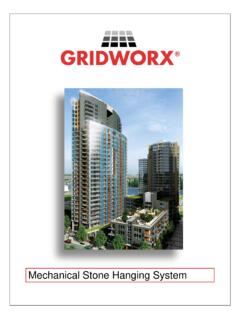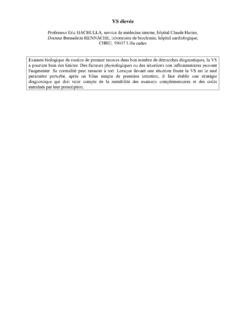Transcription of Background Flexible Mesh - Streamline …
1 800-828-SLTI Background ICPR began as a 1D hydrologic and hydraulic (H&H) model more than 30 years ago with a focus on modeling hydraulically interconnected and inter-dependent pond systems. Hydrodynamic channel and pipe flow were added in the late 1980s. ICPR was the first proprietary H&H model to be formally accepted by FEMA nationally (1995) for use on Flood Insurance Studies. In 2008, a quasi-2D groundwater module was added (PercPackTM) which was our first foray into integrated surface water groundwater modeling. Our latest generation of ICPR, released in 2014, includes fully integrated 2D surface water and groundwater flow with an emphasis on interactions between surficial aquifer systems and surface water bodies.
2 Traditional 1D H&H 2D Overland Flow 2D Groundwater Flow Single Event Simulation Continuous Simulation Georeferenced Graphic System All Modules Fully Integrated The combination of integrated surface water groundwater flow and continuous simulation opens the door to many complex water resources applications and issues such as wetland hydro-period assessments, wetland restoration, impacts of sea level rise on groundwater tables, consumptive water use, stormwater reuse, water sustainability, irrigation demands, and construction dewatering. Flexible mesh The 2D computational framework for ICPR is based on a Flexible unstructured triangular mesh . This approach allows the mesh to shrink where detail is needed and to grow in less critical areas.
3 The result can be orders of magnitude fewer computational cells than a square cell mesh without loss of detail in critical areas. And, fewer cells mean less computational effort, faster run times, and smaller output files. The 1D H&H module of ICPR is fully integrated with the 2D overland flow module. Both 1D and 2D equations are solved simultaneously eliminating awkward numerical handoffs between modules. Storm inlets and underground pipe systems are easily incorporated into the model. Models from Maps Although it is possible to work in schematic mode for 1D projects, ICPR s full power is realized through its georeferenced graphic system. Models are constructed and parameterized directly from various types of maps.
4 Detailed 1D/2D Urban Flood Study Computational meshes are automatically generated from graphical elements that: (1) characterize the terrain; (2) interface with 1D components; and, (3) establish boundary conditions. The mesh is then intersected with surfaces ( , terrain) and thematic polygon map layers. The thematic polygon maps further refine the mesh into subsets of soil zones, impervious zones, roughness zones, and rainfall zones among others. 1D Surface Flow ICPR uses a link node concept in its 1D module. Nodes are placed at strategic locations in the drainage network. Elevations are calculated at nodes based on inflows, outflows and storage characteristics.
5 Water is moved from node to node via links such as pipes, channels, weirs, pumps, and bridges among others. The full St. Venant equations are used for channel and pipe flow. Energy and diffusive wave options are also available. Stormwater runoff can be calculated using traditional unit hydrographs if desired, and delivered to any node in the model. Several options are available for infiltration losses and rainfall excess computations including the curve number method, the Green-Ampt method, a vertically layered kinematic method and a vertically layered dynamic method based on Richards equation. ICPR includes a number of tools to help expedite 1D model construction.
6 These tools extract data from map and surface layers. For example, a breakdown of soil and land cover combinations for each catchment area can be automated inside 800-828-SLTI ICPR. Channel cross sections can be extracted from a ground surface DEM, as well as storage characteristics for lakes, detention ponds, and wetland depressions. Water surface profiles can be animated along any user defined link path. 2D Overland Flow Computational Methods ICPR uses the finite volume method for 2D overland flow computations. This technique is based on a double mesh where momentum equations are lumped along triangle edges and the mass balance equations are lumped into irregular shaped polygons ( the honeycomb ) formed around the triangle vertices.
7 Water surface elevations are calculated at the triangle vertices and water is moved from polygon to polygon along the triangle edges. mesh generation is fully automated, including parameterization. For example, the honeycomb mesh is intersected with land use zones and soil zones to form a set of sub-polygons. Direct rainfall is applied to and infiltration losses calculated for each sub-polygon. Rainfall excess is summed by honeycomb and delivered to its respective triangle vertices. The "Honeycomb" The triangular mesh and corresponding honeycomb are Flexible and unstructured, allowing the mesh to grow and shrink as needed to capture critical areas in the drainage system.
8 Graphical Elements A variety of graphical elements are included in ICPR that allow you to customize and finesse mesh construction. The graphical elements are categorized as follows: Terrain Characterization Interface with 1D Elements Establish Boundary Conditions For example, breaklines are used to define local ridges and valleys. A triangle edge is guaranteed along the breakline, and as mentioned, flow occurs along triangle edges. Strategic placement of a breakline can prevent artificial blockage along flow paths or tunneling through a ridge. There are a total of 18 2D overland flow graphical elements. These can be drawn manually inside ICPR, or imported from shapefiles.
9 Animations The typical way to review results for 2D modeling is with animations. ICPR includes a wide variety of possible animations for 2D overland flow including flow and velocity vectors, depth of flow, maximum depth of flow and water surface elevations among others. Animations can be viewed in play mode or you can manually step through them. 800-828-SLTI You can also go directly to a specific point in time. Most animations can be paused and then exported by simply right-clicking on the animation view. 2D Groundwater Computational Methods The 2D groundwater module in ICPR is based on the finite element method with a 6-point quadratic triangular element.
10 Heads Calculated at Nodes Saturated Horizontal Flow Seepage at Ground Surface Leakage Through Confining Layer The focus of the groundwater module is the surficial aquifer and its interaction with surface water bodies. It includes seepage between the ground surface and the surficial aquifer as well as vertical leakage through a confining layer. Seepage and leakage are bi-directional. Spatiotemporal boundary conditions can be applied below the confining layer. Like the surface, a honeycomb is formed around the vertices of the triangular computational mesh . But unlike the surface, the honeycomb is also formed around mid-nodes. The surface and groundwater honeycombs are intersected with one another and with soil zones, impervious zones and rainfall zones.







